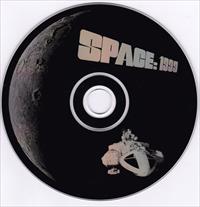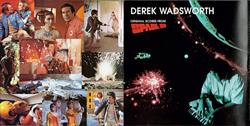Records, tapes and CDs
Compiled by Martin Willey
US 1996
CD No. DWCD 001. $29.99 "Produced for the promotional purposes of the composer only. Public sale is strictly prohibited"r


While the original 24-track master tapes were stored by ITC, Wadsworth kept a personal copy of his music on 7.5 inch tape. Starlog features editor David Hirsch and Silva Screen records Los Angeles chief Ford Thaxton offered to make a private promotional CD for Wadsworth using these personal tapes (via a DAT copy). As promised, they sent him 100 copies of the CD. Shortly afterwards, the CD started being sold from commercial retailers in the US and UK, distributed by standard soundtrack wholesalers. These extra commercial copies were unlicensed by ITC/Polygram and Wadsworth, and they did not receive any royalties on the sales. It is unknown who made or released these extra copies.
See letter by Derek Wadsworth in FAB #31 (January 1997) p31 : True to their word, the CDs were made and I still have around 80 copies left here now. They are useful as, for instance, I have recently beep approached about a forthcoming series for which I was able to send off a CD to the director as a work sample. I understood that in the States a number of fans wanted to hear the music, so Ford and David may have let them have some copies for cost, I don't know. Where the commercially-released versions are coming from I have no idea. I am utterly amazed at the prices charged that I hear about, but I get no profit from these sales whatsoever. The rights of the recordings belong currently, I understand, to PolyGram, although the rights of musical performance belong to Michael Jackson who bought out the rights from Lew Grade's ATV Music along with all the Beatles' songs. It's all a mystery to me... Perhaps Commander Koenig could sort it out!
Note that the 2 CD set Space: 1999 - Original Television Soundtrack- Year Two (Fanderson, 2000) and later versions, Space: 1999 Year Two (Silva Screen, 2009) and Space: 1999 - Original Television Soundtrack- 40th Anniversary Edition - Year Two (Fanderson, 2016), used the original 24-track masters, rather than the 7.5 inch tape on this CD.
The cover is the ITC US Year Two promotional painting of the characters. The 3 page booklet contains a short essay on the production background of Year Two, and a biography of Derek Wadsworth, written by Hirsch.


Leaflet notes by David Hirsch:
SPACE: 1999
September 13th, 1999. A massive series of explosions at the nuclear waste dumps on the far side of the moon hurl the Earth's satellite out of orbit and into interstellar space, On its surface, the 311 men and women of Moonbase Alpha are trapped; doomed to wander the galaxy forever. Space warps, wormholes and black stars propel them further and further into uncharted territory. Unable to control their course, they are left at the mercy of the dark forces of the universe.
Premiering in the autumn of 1975 in America, the UK and most world television markets, Space: 1999 was a huge success for ITC Entertainment. So popular, in fact, that the company quickly ordered series creator/ producer Gerry Anderson to reassemble much of the cast and crew to produce another season of twenty-four hour-long adventures, In a bid to establish themselves as a major American television supplier, ITC financed the first series of twenty-four episodes at the then unheard-of sum of $275,000.00 per episode. Martin Landau and Barbara Bain led the multi-national cast and several American writers were brought in to tailor the series to the US which was then still the largest television market in the world,
Despite its success, ITC took to heart criticism that the first season lacked humor and spent too much time on high concept sci-fi plots. Anderson was ordered to revamp the format by focusing more on physical action and personal interaction between the Alphans. Fred Freiberger, producer of the third season of the original Star Trek series, was brought on to replace the departed Sylvia Anderson.
Influenced by 2001: A Space Odyssey, the first season had an epic film quality with lavish sized sets and dark, moody lighting; although it took over a year to shoot the complex, stylized photography. With the new season scheduled to air only months away, the company had to streamline the production process, By downsizing to one sound stage of principal sets, placing the characters in a tight-knit environment, the action was brought closer to home. Several episodes were shot simultaneously, so stars Landau and Bain would lead the cast with backup from the series two new supporting characters: dashing second-in-command Tony Verdeschi (played by Tony Anholt) and Maya (Catherine Schell), a beautiful alien with the ability to transform into any living creature, Both couples would carry on blooming love affairs to give the show an emotional feel the first season lacked.
While set designer Keith Wilson and effects men Brian Johnson and Nick Allder continued to maintain the visual look they created for the previous twenty-four episodes, Anderson turned to Derek Wadsworth to devise a musical format completely different from the classical-styled orchestral score created by the late Barry Gray. Wadsworth drew on his background in jazz and pop music to give Space: 1999 s new action style even more dramatic power,Unlike today's television series, Wadsworth scored only five episodes, composing just over two hours of music that would be adapted to the other nineteen episodes, The Metamorph, The Exiles and One Moment Of Humanity were the first three episodes to be shot and scored, Their music was typical of much of the series until episode sixteen, Space Warp, which featured a greater amount of action material. Wadsworth was an early innovator of mixing an acoustic orchestra with electronics for the show to achieve a characteristic sound not available from contemporary instrumentation, A more lighthearted motif underscored his work on episode six, The Taybor, which is not included in this collection.
Currently, Space: 1999 is running in America on the Sci-Fi Channel, in several markets worldwide and is expected to air again in the UK shortly.
DEREK WADSWORTH
The scoring of an action series the calibre of Space: 1999 required the talents of no ordinary composer, and Derek Wadsworth is far from ordinary! His career, spanning over forty years, has called upon his talents as a composer, arranger, conductor and musician for such diverse musical stars as The Beatles, The Rolling Stones, Rod Stewart, Charles Aznavour, Diana Ross, Tony Bennett, Simply Red and many more.
Born in West Yorkshire, Wadsworth started his musical career when he joined a brass band at the age of ten. He studied the trombone until he was able to join the Brighthouse and Rastrick Band Unable to afford a proper musical education, he learned the basics of arranging and composition through a correspondence course, He was tutored in the art of conducting under the guidance of the Band's leader.
In the 1960s, Wadsworth performed as a session musician in various bands and on several record albums, 1964 saw his career take a giant leap forward when he began a long relationship with pop singer Dusty Springfield as her arranger. This led to professional associations with artists on both sides of the Atlantic, including Judy Garland, Shirley Bassey and Nina Simone. Wadsworth also branched out into television as the award-winning writer/producer of over 120 commercials, In 1968, he began a five-year stint as the musical director for the London company of Hair, directing two hit albums with performers Alex Harvey and Mike Oldfield.
The composer's many film and television credits include The Whales Of August, the thirteen-part series Puppydog Tales and, as arranger and musical director, The Man Who Fell To Earth and Dick Tracy. In 1975, he was called to score Gerry Anderson's The Day After Tomorrow (Into Infinity in the UK), a one-hour television pilot Wadsworth caught the producer's ear and he was quickly signed to compose music for the new series of the international hit Space: 1999.
Since then he has written compositions for most of the major UK symphony orchestras, including nineteen albums as arranger and music supervisor with the Royal Pops Orchestra. Under the pseudonym of "Daniel Caine", he has recorded seventeen albums and, under his own name, two albums of film music with the City of Prague Symphony Orchestra.
Wadsworth has recently scored the BBC series The Seven Wonders Of The World and two television pilots for director David Lane. Currently, he is the musical director and producer for Bill Tarmey on a five-album deal with EMI. Their first recording went gold in three weeks and the second had pre-sales of over 80,000 copies.
Copyright Martin Willey